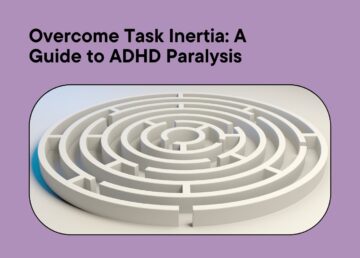
Burnout – a term that’s been a part of general workplace discourse for the past few years – often appears to be disregarded as stress. However, while burnout is caused by immense and prolonged exposure to stress, these two are different.
Simply put, burnout is a state of physical, mental, and emotional exhaustion caused by excessive stress over a long period. It’s not a medical condition but rather a syndrome that appears due to extensive exposure to stress.
This syndrome is most commonly followed by feeling overwhelmed, emotionally drained, and unable to meet constant demands at work, as a caregiver, or in other demanding responsibilities.
Therefore, as the stress continues, you begin to lose the interest or motivation that once drove you to accomplish your tasks, and you become cynical toward things that used to be enjoyable.
In this article
What Causes Burnout?
Burnout can occur when there is a mismatch between the demands of a job or situation and the resources available to meet those demands. Common causes include:
- Working long hours or having an excessive workload
- Having little control over how you do your job
- Feeling unappreciated or undervalued at work
- Having unclear job expectations
- Working in an emotionally demanding environment
- Having little social support
- Having too many responsibilities
- Having too much change
- Having an unsupportive work environment
Job burnout is likely the most common type of the syndrome. However, you might be experiencing burnout because of other responsibilities, such as parenting or caring for a family member, personal projects piling up, and other demanding areas of your life.
It’s important to understand that burnout doesn’t happen overnight – it’s a gradual process that occurs over more extended periods of time and might not feel wrong at first.
Psychology defines 5 stages of burnout:
- The honeymoon phase
- The onset of stress phase
- The chronic stress phase
- The burnout phase
- The habitual burnout phase
Combating this mental state at any stage is possible, but it’s vital to catch it as soon as possible and take necessary action.
Types of Burnout
Recent psychology analysis has identified 3 main types of burnout that affect your mental health and performance in various fields. These are:
Overload burnout
Overload burnout is the most common type of this syndrome. It happens when you are constantly under work-related stress due to a fast-paced work environment, long working hours, and little to no breaks.
This chronic stress jeopardizes your well-being and significantly affects your personal life. Job stress can be solved by setting boundaries or talking to your superiors about the workload.
Occupational stress is a common experience for many, and it’s closely related to hustle culture. If you feel you’re losing interest, becoming cynical, and indifferent to your job, you might be burned out.
Under-challenged burnout
On the other side of the burnout spectrum is the under-challenged type. If you don’t feel challenged or mentally stimulated at your job, it can lead to motivation loss.
The gradual process of feeling no motivation to work leads to being burned out, but instead of too much stress, you don’t feel any.
While it might be good not to feel any distress, stress can be a great motivator if experienced in moderation.
Neglect burnout
If your job makes you feel like it has no purpose, staying motivated and engaged with your everyday tasks can be challenging.
An unfulfilling career and lack of purpose in what you do causes mental exhaustion, affects your physical and mental health, and can cause burnout symptoms.
Typical Physical and Mental Symptoms of Burnout
Burnout can manifest itself in a multitude of symptoms that affect your health. Common symptoms can be classified into physical, mental, and behavioral symptoms:
Physical signs of burnout
- Stomach aches
- Headaches
- Disrupted sleep habits
- Fatigue and feeling tired all the time
- Physical health conditions
Behavioral signs of burnout
- Change in eating habits
- Change in sleeping habits
- Frustration over little things
- Self-defeating behaviors (e.g., substance abuse)
Emotional signs of burnout
- Cynicism toward work or other important areas
- Feeling hopeless
- Lack of motivation
- Feelings of anxiety and depression
Other symptoms include difficulty concentrating and taking in new information, detachment from things you love, difficulty maintaining social relationships, nervous system exhaustion (e.g., heart system dysfunction), and others.
If you or someone you know are dealing with burnout, it’s essential to take adequate measures, such as talking with medical professionals or employing digital tools to assist you.
How to Prevent and Address Burnout Symptoms
It’s not easy to overcome this syndrome and improve your general mental wellness. However, some techniques can alleviate symptoms and build resilience for the future.
Two main areas need attention when dealing with burnout: addressing the key reason of burnout and promoting your physical and emotional health.
Managing job burnout or other sources of stress
First, it’s crucial to identify and address the source of your stress. It can be your job, being a caregiver, or caused by other areas of life. However, by knowing the root problem, you can come up with solutions easier.
Set boundaries and develop healthy coping mechanisms
Having clear boundaries helps you manage your workload better – you can say “no” if you have enough tasks on your plate. Also, take occasional breaks during work hours as it’s essential to recharge and step away for a minute to remain productive and content.
People who experience burnout have certain coping mechanisms to help them get through the day.
However, unhealthy coping mechanisms, such as alcohol or substance abuse, bring more harm than good. Use healthy coping strategies, such as journaling, meditation, and mindfulness practices, to manage daily stress and other burnout symptoms.
Work-life balance
Clearly distinguish work and leisure hours to better control your time and take a moment to recharge, socialize, and engage in hobbies. Having a clear distinction between work and personal life hours will help manage symptoms.
Care for your physical health
A healthy diet, physical exercise, and adequate healthcare, if you’re experiencing issues, can make a significant difference in getting your life in order. If you don’t know where to start, try to devise a healthy daily routine or consult with healthcare professionals.
Caring for your health will assist with managing physical symptoms of burnout and improve your overall well-being.
Prioritize mental health
Practice self-care, address pre-existing conditions, use stress management techniques, and work toward a healthier life. Again, you can devise a plan for your mental contentment, utilize digital tools, or consult a mental health professional.
Have support
Social contact with others is essential to being human – we need socialization to feel connected and validated. Regularly hang out with your family members, friends, and even co-workers. Seeing a therapist can also be beneficial to some.
Job burnout is quite common, so talking with others can bring you some relief that you’re not dealing with this syndrome alone.
The Road to Better Mental Health
Being burned out is a real problem that many people face every day. Not feeling your best and being indifferent to things you used to like can sometimes feel like the end of the world, but luckily, it’s possible to overcome it.
While the road to recovery and an improved mindset might not be easy, it’s essential to recognize the signs to stop burning out, prevent burnout in the future, and start thriving again.
Frequently Asked Questions
How to get rid of burnout?
Burnout is a state of emotional, physical, and mental exhaustion caused by prolonged or excessive stress. It can be caused by a variety of factors, including work, relationships, and personal issues. If you’re feeling burnt out, there are a number of things you can do to help yourself recover.
- Identify the source of your burnout. Once you know what’s causing your stress, you can start to address it. This may involve making changes to your work, relationships, or lifestyle.
- Prioritize self-care. Make sure to take time for yourself to relax and recharge. This includes getting enough sleep, eating healthy foods, and exercising regularly.
- Practice mindfulness. Mindfulness techniques, such as meditation and deep breathing, can help to reduce stress and improve your overall well-being.
- Build strong support networks. Talk to friends, family, or a therapist about how you’re feeling. Having a strong support network can help you to cope with stress and feel better emotionally.
- Seek professional help if needed. If you’re struggling to manage your burnout on your own, talk to a therapist or counselor. They can help you develop a personalized plan to address your burnout.
How do I know if I’m burnt out?
Burnout can manifest in a variety of ways. Some common symptoms of burnout include:
- Emotional exhaustion: Feeling drained, depleted, and emotionally overwhelmed.
- Physical fatigue: Experiencing physical symptoms such as fatigue, headaches, and muscle tension.
- Mental cynicism: Feeling cynical, negative, and detached from work or other activities.
- Reduced productivity: Experiencing difficulty concentrating, making decisions, and completing tasks.
- Irritability and mood swings: Feeling easily irritated, frustrated, and experiencing mood swings.
- Loss of motivation: Feeling unmotivated, disengaged, and lacking interest in activities that you once enjoyed.
If you’re experiencing any of these symptoms, it’s important to seek help from a healthcare professional to rule out any underlying medical conditions.
What’s the cure for burnout?
There is no one-size-fits-all cure for burnout, as the best treatment plan will vary depending on the individual’s needs and circumstances. However, there are a number of things that can help to relieve symptoms and promote recovery.
- Address the underlying cause of stress. If you’re feeling burnt out at work, talk to your boss or manager about ways to reduce your workload or improve your work-life balance. If you’re feeling burnt out in your personal life, talk to your partner or family members about how they can support you.
- Take time for yourself. Make sure to schedule time for activities that you enjoy and that help you relax and de-stress. This could include spending time with loved ones, exercising, reading, or taking up a new hobby.
- Practice stress management techniques. There are a number of stress management techniques that can help to reduce your stress levels, such as meditation, yoga, or deep breathing exercises.
- Seek professional help if needed. If you’re struggling to cope with burnout on your own, talk to a therapist or counselor. They can help you develop a personalized plan to address your burnout and develop coping mechanisms.
What typically causes burnout?
Burnout can be caused by a variety of factors, including:
- Work-related stress: Long hours, excessive workload, unrealistic deadlines, and a lack of control over your work can all contribute to burnout.
- Personal stress: Difficult relationships, financial problems, and chronic health conditions can all put additional strain on your mental and emotional well-being.
- Lack of work-life balance: If you’re constantly working and not taking time for yourself, you’re more likely to experience burnout.
- Perfectionism: Setting unrealistic expectations for yourself and feeling like you can never do enough can lead to burnout.
- Avoidance of emotions: If you’re not dealing with your emotions in a healthy way, they can build up and lead to burnout.
References:
- Kakiashvili, T., Leszek, J. and Rutkowski, K., 2013. The medical perspective on burnout. International journal of occupational medicine and environmental health, 26, pp.401-412.
- Bayes, A., Tavella, G. and Parker, G., 2021. The biology of burnout: Causes and consequences. The World Journal of Biological Psychiatry, 22(9), pp.686-698.
- Montero-Marin, J., Prado-Abril, J., Piva Demarzo, M.M., Gascon, S. and García-Campayo, J., 2014. Coping with stress and types of burnout: explanatory power of different coping strategies. PloS one, 9(2), p.e89090.
- Vladut, C.I. and Kallay, E., 2010. Work stress, personal life, and burnout. Causes, consequences, possible remedies:-a theoretical review. Cognition, Brain, Behavior, 14(3), p.261.
- Ashton-James, C.E., McNeilage, A.G., Avery, N.S., Robson, L.H. and Costa, D., 2021. Prevalence and predictors of burnout symptoms in multidisciplinary pain clinics: a mixed-methods study. Pain, 162(2), pp.503-513.
- Awa, W.L., Plaumann, M. and Walter, U., 2010. Burnout prevention: A review of intervention programs. Patient education and counseling, 78(2), pp.184-190.





